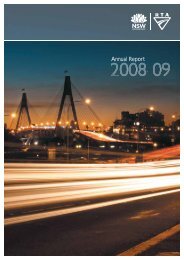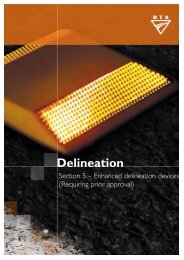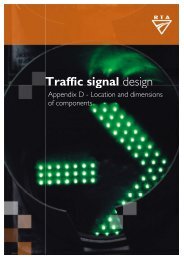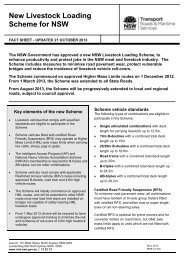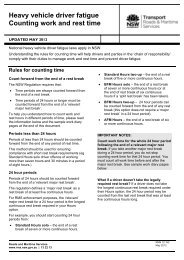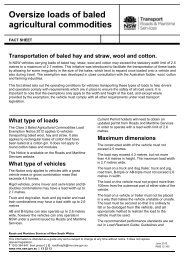Bega bypass - RTA
Bega bypass - RTA
Bega bypass - RTA
You also want an ePaper? Increase the reach of your titles
YUMPU automatically turns print PDFs into web optimized ePapers that Google loves.
ISBN 978-1-921766-60-2<br />
<strong>Bega</strong> <strong>bypass</strong><br />
Review of Environmental Factors<br />
VOLUME 2 / SEPTEMBER 2010<br />
<strong>RTA</strong>/Pub. 10.291<br />
2
Roads and Traffic Authority<br />
<strong>Bega</strong> Bypass<br />
Review of Environmental Factors<br />
September 2010
VOLUME 2 – Appendices<br />
Appendix B – Consultation Material<br />
Appendix C – Biodiversity Assessment<br />
Appendix D – Noise and Vibration Assessment<br />
Appendix E – Visual Impact Assessment<br />
Appendix F – Greenhouse Assessment<br />
Appendix G – Aboriginal Heritage Assessment<br />
Appendix H – Socio-economic Assessment<br />
21/18937/157350<br />
<strong>Bega</strong> Bypass<br />
Review of Environmental Factors
21/18937/157350<br />
Appendix A<br />
Environmental Checklists<br />
Consideration of the Clause 228 factors under the EP&A Act<br />
Matters of national environmental significance under the<br />
EBPC Act<br />
<strong>Bega</strong> Bypass<br />
Review of Environmental Factors
Clause 228 Checklist<br />
The following factors, listed in Clause 228(2) of the Environmental Planning and Assessment Regulation<br />
2000, are required to be considered to assess the likely impacts of the proposal on the natural and built<br />
environment.<br />
Factor Impact<br />
a. Any environmental impact on a community?<br />
The proposal would result in short-term negative impacts to the local community as a<br />
result of construction noise and traffic as discussed in sections 6.2 and 6.4. Potential<br />
traffic impacts include an increase in the volume of heavy vehicles, changes in speed<br />
limits and local traffic changes. Construction noise impacts would be managed by<br />
adopting reasonable and feasible noise management measures identified in the<br />
DECCW Interim Construction Noise Guideline in order to reduce noise levels as much<br />
as possible during construction.<br />
Long-term positive impacts would increase road safety, travel efficiencies and reduce<br />
vehicle numbers within the main street of <strong>Bega</strong>. The proposal provides capacity for the<br />
road to accommodate future traffic increases and provides better access particularly for<br />
heavy vehicles, than is provided by the existing alignment.<br />
b. Any transformation of a locality?<br />
The proposal would result in substantially less traffic in the centre of <strong>Bega</strong>; through<br />
traffic would be routed west of the town. This would increase amenity and safety in the<br />
<strong>Bega</strong> CBD. The roundabout proposed at the northern end of the route would change<br />
the character at the entrance of the town.<br />
The traffic alterations may affect the level of tourism and trade within the town, as a<br />
result of less passing traffic through <strong>Bega</strong>. However, amenity in the town centre would<br />
be improved as a result of reduced vehicle numbers and trade may be enhanced.<br />
Residences on the western edge of <strong>Bega</strong>, where the <strong>bypass</strong> would be located, would<br />
be subject to increased visual, and noise impacts. No transformation of the locality is<br />
anticipated as a result of the proposal.<br />
c. Any environmental impact on the ecosystems of the locality?<br />
The proposal would include the removal of approximately 12 hectares of nativedominated<br />
pasture including 6.95 hectares of Lowland Grassy Woodlands endangered<br />
ecological community. In the northern section, drainage lines feed into Freshwater<br />
wetland endangered ecological communities. Mitigation measures require that natural<br />
hydrological regimes are retained as much as possible and water quality risks (from<br />
chemical spills or sediment) are managed. In the southern section, resources that would<br />
be removed include mature hollow-bearing trees, which are a declining resource under<br />
pressure from development in the locality. Loss of hollows would be mitigated by<br />
installation of nest boxes..<br />
The loss of this vegetation is not considered to result in significant impacts to any<br />
threatened species (refer to section 6.1). Mitigation measures include noxious weed<br />
control and revegetation of disturbed areas.<br />
21/18937/157350<br />
<strong>Bega</strong> Bypass<br />
Review of Environmental Factors<br />
Short-term<br />
negative<br />
Long-term<br />
positive and<br />
negative<br />
Long-term<br />
positive<br />
Long-term<br />
negative<br />
Long-term minor<br />
negative
Factor Impact<br />
d. Any reduction of the aesthetic, recreational, scientific or other<br />
environmental quality or value of a locality?<br />
There would be a minor reduction in the aesthetic quality of the locality due to the<br />
removal of vegetation and increase in road infrastructure on the western side of <strong>Bega</strong> in<br />
an area that is currently undeveloped. Mitigation measures would be implemented to<br />
reduce visual and noise impacts. Revegetation of disturbed soils would be undertaken<br />
as part of the works program. The amenity of the <strong>Bega</strong> CBD and the existing highway,<br />
would be improved after the <strong>bypass</strong> is in operation, as a result of less traffic, enhanced<br />
safety and reduced noise in these areas.<br />
e. Any effect on a locality, place or building having aesthetic,<br />
anthropological, archaeological, architectural, cultural, historical, scientific or<br />
social significance or other special value for present or future generations?<br />
The proposal would destroy Aboriginal artefacts within the soil profile in the proposal<br />
footprint. The archaeological deposit is assessed to be of low scientific significance and<br />
does not surpass significance thresholds which would act to preclude impacts. A<br />
Section 90 consents has been be obtained for the Aboriginal heritage items. Refer to<br />
sections 6.7.1 and 6.9 for heritage impact assessments.<br />
The view to the <strong>Bega</strong> River and associated wetlands was considered of potential<br />
significance. Measures to retain the drainage line hydrology feeding natural lagoons are<br />
proposed however, substantial cut and fill works would affect the ridgelines overlooking<br />
the wetlands. Visual amenity impact mitigation and rehabilitation measures to restore<br />
disturbed areas are part of the proposal.<br />
There are no identified non-Aboriginal heritage items located within the proposal<br />
footprint. Most of the adjacent residences are of modern construction. Any buildings in<br />
the area of any potential heritage significance would not be impacted by the proposal.<br />
f. Any impact on the habitat of protected fauna (within the meaning of the<br />
National Parks and Wildlife Act 1974)?<br />
Native fauna would be impacted through removal of habitat including six hollow-bearing<br />
trees. If hollow bearing trees are not able to be retained then nest boxes would be<br />
installed in remaining trees to mitigate the loss of hollows. The site is already<br />
fragmented for all but highly mobile fauna such as bats and birds. Further fragmentation<br />
of habitat as a result of vegetation removal is unlikely to have a significant impact to<br />
local fauna. Refer to section 6.1 for an assessment of impacts to fauna habitat.<br />
g. Any endangering of any species of animal, plant or other form of life,<br />
whether living on land, in water or in the air?<br />
The proposal would remove habitat for a number of species. Assessments of<br />
Significance have been undertaken for a number of threatened species known to be<br />
present in the locality (refer to section 6.1).<br />
These assessments found that there would be no significant impact to any of these<br />
species and therefore the species would not be endangered as a result of the works<br />
(refer to Appendix C). No Assessments of Significance were considered to be<br />
warranted for threatened flora species.<br />
Impacts to non-listed native fauna have been assessed. It is considered unlikely that<br />
high rates of roadside fatality would occur for wombats, or other fauna such as<br />
kangaroos and wallabies.<br />
21/18937/157350<br />
<strong>Bega</strong> Bypass<br />
Review of Environmental Factors<br />
Long-term minor<br />
negative<br />
Long-term minor<br />
negative<br />
Long-term<br />
negative<br />
Nil
Factor Impact<br />
h. Any long-term effects on the environment?<br />
The proposal would have a positive long-term impact through improved reduced vehicle<br />
numbers through the <strong>Bega</strong> CBD and the capacity for the road to better accommodate<br />
heavy vehicles as well as increased vehicle numbers. It would have a positive long-term<br />
impact on road safety by reducing the number of traffic movements and directing<br />
through traffic away from the centre of <strong>Bega</strong>. It would thereby improve the amenity of<br />
the centre of <strong>Bega</strong>, for businesses, residents and tourists alike.<br />
Long-term negative impacts include an increase in the amount of road infrastructure in<br />
<strong>Bega</strong> in what is now pasture overlooking the <strong>Bega</strong> River and natural lagoons. The<br />
proposal would also impact on biodiversity through the removal of approximately 12<br />
hectares of native-dominated pasture and clearing of Lowland Grassy Woodland<br />
endangered ecological community. Six hollow-bearing trees would be removed however<br />
hollows lost would be mitigated by installation of nest boxes..<br />
i. Any degradation of the quality of the environment?<br />
The proposal would remove approximately 12 hectares of native-dominated pasture<br />
and six hollow-bearing trees. The site would be rehabilitated post-construction which<br />
would reduce the risk of long-term degradation to the environment. Mitigation measures<br />
would be implemented to control and prevent spread of noxious weeds during<br />
construction.<br />
Water quality could be reduced as a result of pollutants such as sediment, soil nutrients<br />
and waste entering drainage lines, particularly during high rain events. Spillage of fuel<br />
during refuelling and leakage of hydraulic and lubricating oil from plant and equipment<br />
or rinse water from plant washing and concrete slurries would also have the potential to<br />
enter drainage lines. Mitigation measures would be implemented to reduce impacts to<br />
water quality. Theses are provided in section 6.10.3.<br />
Air quality and noise impacts would be associated with the construction phase. Noise<br />
attenuation forms part of the proposal for dwellings which would be adversely affected<br />
by noise from the operational <strong>bypass</strong>.<br />
j. Any risk to the safety of the environment?<br />
There is potential for traffic safety to be reduced during construction however as the<br />
<strong>bypass</strong> has only two major tie in points with the existing Princes Highway alignment,<br />
these are considered manageable. Traffic management measures include the<br />
development of a Traffic Management Plan to address safety risks.<br />
The proposal would increase the long-term safety of the road by reducing the number of<br />
turning movements, separating through traffic and thereby reducing overall vehicle<br />
numbers in the centre of <strong>Bega</strong>.<br />
k. Any reduction in the range of beneficial uses of the environment?<br />
There would be a minor impact on agricultural and residential land uses in the road<br />
corridor, however the majority of this land has been vacant for some time. The plans to<br />
develop this <strong>bypass</strong> are well known and have been well communicated to the<br />
community.<br />
l. Any pollution of the environment?<br />
The proposal would result in minor short term air pollution from plant and machinery<br />
required for construction and potential dust generation. Air quality could be reduced in<br />
the long term from current conditions on the western edge of the town, which is<br />
currently undeveloped agricultural land.<br />
There is a potential for chemical and fuels spills to occur during construction which<br />
includes pollution events at waterways. The risk of spills would be managed through the<br />
implementation of a spill management plan to include the use of spill kits, worker<br />
training and erosion and sediment controls.<br />
21/18937/157350<br />
<strong>Bega</strong> Bypass<br />
Review of Environmental Factors<br />
Long-term<br />
positive and<br />
negative<br />
Short term<br />
negative,<br />
Long term nil<br />
Potential shortterm<br />
negative<br />
Long-term<br />
Positive<br />
Long-term minor<br />
negative<br />
Short-term and<br />
long-term minor<br />
negative
Factor Impact<br />
m. Any environmental problems associated with the disposal of waste?<br />
It is not anticipated that there would be any contaminated waste as a result of the<br />
proposal. Other waste streams generated during construction are common and would<br />
pose no difficulty in their disposal. Waste would be recycled wherever possible. This<br />
includes the reuse of excess cut material.<br />
n. Any increased demands on resources (natural or otherwise) that are, or<br />
are likely to become, in short supply?<br />
All resources required for the proposal are readily available and are not in short supply.<br />
o. Any cumulative environmental effect with other existing or likely future<br />
activities?<br />
Traffic efficiencies and the increased safety for motorists on the new <strong>bypass</strong> and within<br />
the town centre, where traffic pressure would be decreased, constitute long-term<br />
cumulative benefits of the proposal. The proposal is also part of a series of upgrades to<br />
the Princes Highway to improve safety on the NSW road network.<br />
Local developments proposed include <strong>Bega</strong> civic space and retail development in the<br />
centre of <strong>Bega</strong>, two blocks east of the proposed <strong>bypass</strong> route, as well as residential and<br />
industrial developments proposed at the southern section of the route.<br />
Should construction timetables overlap, there would be cumulative noise, visual, air<br />
quality and traffic/access impacts for the community in these areas. Particularly relevant<br />
to the southern section, increased development places increasing pressure on remnant<br />
vegetation which provides important resources (water sources, hollows) for the wide<br />
ranging fauna able to utilise these fragmented landscapes. Mitigation measures have<br />
been provided throughout this REF to minimise any potential impacts of the proposal.<br />
21/18937/157350<br />
<strong>Bega</strong> Bypass<br />
Review of Environmental Factors<br />
Nil<br />
Nil<br />
Long-term<br />
negative and<br />
positive
Matters of National Environmental Significance<br />
Under the environmental assessment provisions of the Environment Protection and Biodiversity<br />
Conservation Act 1999, the following Matters of National Environmental Significance are required to be<br />
considered to assist in determining whether the proposal should be referred to the Australian<br />
Government Department of the Environment, Water, Heritage and the Arts.<br />
Factor Impact<br />
a. Any impact on a World Heritage property?<br />
The proposal would not have any impact on a World Heritage property. There are<br />
no World Heritage properties within 10 kilometres of the proposal site.<br />
b. Any impact on a National Heritage place?<br />
The proposal would not have any impact on a National Heritage place. There are<br />
no National Heritage places within 10 kilometres of the proposal site.<br />
c. Any impact on a wetland of international importance?<br />
The proposal would not have any impact on a wetland of international importance.<br />
There are no wetlands of international importance within 10 kilometres of the<br />
proposal site.<br />
d. Any impact on a listed threatened species or communities?<br />
There is some potential for impact to green and golden bell frog (Litoria aurea),<br />
should a population occur in the study area. Potential effects include habitat<br />
degradation of wetlands downstream from the proposal. An EPBC Assessment of<br />
Significance was undertaken in respect of the green and golden bell frog (refer<br />
Appendix C). Given the low potential for a population of green and gold bell frog to<br />
occur in the vicinity of the proposal site, and the mitigation measures to minimise<br />
degradation processes (such as storm water and sedimentation control – refer to<br />
section 6.10.3 of this report) that could impact marginal habitat of this species, it<br />
was considered unlikely that the proposal would have a substantial impact on the<br />
species.<br />
e. Any impacts on listed migratory species?<br />
There is potential for impact to great egrets (Ardea alba), which utilise the wetlands<br />
downslope of the proposal. Degradation of habitat could occur from the effects on<br />
water quality, erosion and sedimentation as well as hydrological changes, during<br />
construction and operation of the proposal. The works may also exacerbate<br />
existing weed infestations. Standard impact mitigation measures would reduce<br />
effects to great egret, including weed control and erosion and sediment controls<br />
(refer to section 6.1.4 of this report). An EPBC Assessment of Significance was<br />
undertaken in respect of the great egret (refer Appendix C), which concluded the<br />
proposal was unlikely to have a substantial impact on this species.<br />
f. Any impact on a Commonwealth marine area?<br />
The proposal would not have any impact on a Commonwealth marine area. No<br />
Commonwealth marine areas occur within or within 10 kilometres of the proposal<br />
site.<br />
g. Does the proposal involve a nuclear action (including uranium<br />
mining)?<br />
The proposal does not involve a nuclear action.<br />
21/18937/157350<br />
<strong>Bega</strong> Bypass<br />
Review of Environmental Factors<br />
Nil<br />
Nil<br />
Nil<br />
Negligible<br />
Negligible<br />
Nil<br />
Nil
Factor Impact<br />
h. Additionally, any impact (direct or indirect) on Commonwealth land?<br />
There are two areas of Commonwealth land within 10 kilometres of the proposal<br />
site, however neither occur within the proposal site. The proposal would therefore<br />
not directly impact Commonwealth land, and is unlikely to indirectly impact<br />
Commonwealth land.<br />
21/18937/157350<br />
<strong>Bega</strong> Bypass<br />
Review of Environmental Factors<br />
Nil
GHD<br />
133 Castlereagh St Sydney NSW 2000<br />
-<br />
T: 2 9239 7100 F: 2 9239 7199 E: sydmail@ghd.com.au<br />
© GHD 2010<br />
This document is and shall remain the property of GHD. The document may only be used for the purpose<br />
for which it was commissioned and in accordance with the Terms of Engagement for the commission.<br />
Unauthorised use of this document in any form whatsoever is prohibited.<br />
Document Status<br />
Rev<br />
No.<br />
Author<br />
21/18937/157350<br />
B James<br />
A Webb<br />
Reviewer Approved for Issue<br />
Name Signature Name Signature Date<br />
K Smallwood<br />
B Marshall<br />
<strong>Bega</strong> Bypass<br />
Review of Environmental Factors<br />
M Roser<br />
15.09.10



